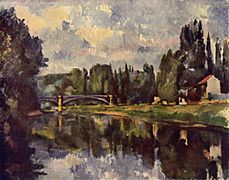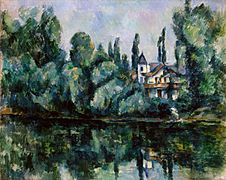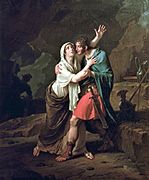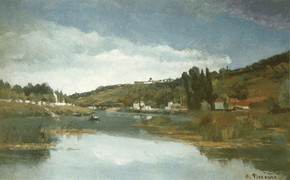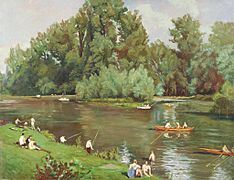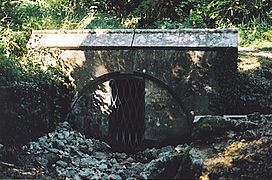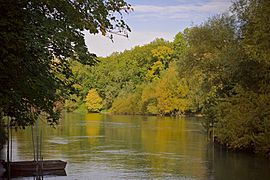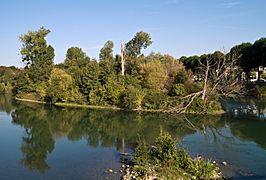Marne (river) facts for kids
Quick facts for kids Marne |
|
| River | |
|
The Marne river in Noisy-le-Grand
|
|
| Country | |
|---|---|
| Regions | Grand Est, Hauts-de-France, Île-de-France, Grand Paris |
| Departments | Haute-Marne, Marne, Aisne, Meuse, Seine-et-Marne, Seine-Saint-Denis, Val-de-Marne |
| Tributaries | |
| - left | Petit Morin, Somme-Soude, Grand Morin, Blaise |
| - right | Rognon, Saulx, Ourcq |
| Cities | Châlons-en-Champagne, Château-Thierry |
| Source | Plateau de Langres |
| - location | Balesmes-sur-Marne, Haute-Marne, France |
| - elevation | 420 m (1,378 ft) |
| - coordinates | 47°49′07″N 5°20′59″E / 47.81861°N 5.34972°E |
| Confluence | Seine River |
| - location | Charenton-le-Pont, Val-de-Marne, France |
| - elevation | 32 m (105 ft) |
| - coordinates | 48°49′01″N 2°24′34″E / 48.81694°N 2.40944°E |
| Length | 513.9 km (319 mi) |
| Basin | 12,660 km² (4,888 sq mi) |
| Discharge | for Gournay-sur-Marne |
| - average | 109 m³/s (3,849 cu ft/s) |
The Marne is an important river in France. It flows into the Seine River on the right side, just east and southeast of Paris. Several French regions and departments are named after it, including Haute-Marne, Marne, Seine-et-Marne, and Val-de-Marne.
The Marne river is also famous for two major battles that happened along its banks during the First World War. These were the first battle in 1914 and the second in 1918.
Contents
About the Marne River
The Marne river is one of the longest rivers in France. It stretches for about 513.9 km (319.3 mi). The area of land that drains into the Marne, called its drainage basin, covers about 12,660 km2 (4,888 sq mi).
The river's average flow, or discharge, is about 109 m3/s (3,800 cu ft/s) of water per second. This measurement was taken near Gournay-sur-Marne in the Seine-Saint-Denis department.
Where the Marne River Starts and Flows
The source of the Marne river is in the Langres Plateau. This is a high, flat area of land. The river begins in a small town called Balesmes-sur-Marne.
The source is located at an altitude of about 420 m (1,378 ft) above sea level. This area is in the Haute-Marne department. The river first flows north, then turns west between Saint-Dizier and Châlons-en-Champagne.
The Marne river flows through four different regions and seven departments. It passes through 218 communes, which are like small towns or local areas. Some of the notable communes it flows through include:
- Grand Est region:
- Haute-Marne : Langres, Chaumont, Saint-Dizier
- Marne : Vitry le François, Châlons-en-Champagne, Épernay
- Hauts-de-France region:
- Île-de-France region:
- Seine-et-Marne : Meaux, Lagny-sur-Marne, Saint-Thibault-des-Vignes, Torcy, Noisiel, Vaires-sur-Marne, Chelles
- Seine-Saint-Denis : Gournay-sur-Marne, Noisy-le-Grand, Neuilly-sur-Marne, Neuilly-Plaisance
- Grand Paris:
- Val-de-Marne : Nogent-sur-Marne, Créteil, Charenton-le-Pont, Champigny-sur-Marne, Saint-Maur-des-Fossés, Joinville-le-Pont, Saint-Maurice, Bry-sur-Marne, Le Perreux-sur-Marne, Maisons-Alfort
Finally, the Marne river joins the Seine River. This happens between Charenton-le-Pont and Alfortville. This area is in the Val-de-Marne department, close to Paris.
Main Rivers Joining the Marne
Many smaller rivers flow into the Marne. These are called tributaries. Here are some of the main ones:
|
Rivers Joining from the Left:
|
Rivers Joining from the Right:
|
Painters Inspired by the Marne
Over the years, the beautiful scenery along the Marne river has inspired many famous painters. They captured its landscapes in their artworks during the 19th and 20th centuries. Some of these artists include:
- Camille Corot;
- Paul Cézanne;
- Pierre Emmanuel Damoye;
- Camille Pissarro;
- Henri Rousseau, also known as "Le Douanier Rousseau";
- Albert Marquet;
- Raoul Dufy;
- André Dunoyer de Ségonzac;
- Louis Vuillermoz;
- Maurice Boitel;
- Daniel du Janerand.
-
Paul Cézanne, Les Bords de la Marne (1888)
-
Paul Cézanne, Les Rives de la Marne, (around 1888)
-
By Pissarro at Chenevières
Gallery
-
The Marne in Château-Thierry
Related pages
Images for kids
See also
 In Spanish: Río Marne para niños
In Spanish: Río Marne para niños



